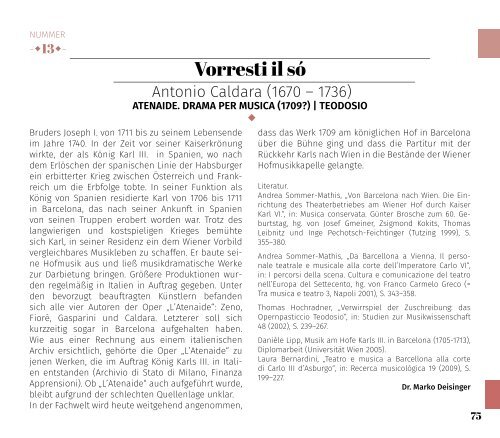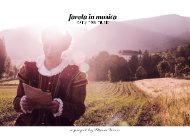Booklet "favola in musica.alte neue musik"
Enjoy the 216 pages fairy tale book inspired booklet of "favola in musica. early new music" in German and English with over 100 photographs, well researched musical texts to each aria, translations of all aria texts in German and English and biographies of all participating members. Music from renaissance, baroque and present time - 3 world premiere recordings from early music (Antonio Caldara, Sebastian Durón) - 2 world premiere recordings of contemporary music (Wolfgang Mitterer) - 1 bonus music-video (included on the CD) Deluxe Edition in a high-quality CD-Hardcover-Digibook, 216 costly designed pages with photos and texts 1607. ensemble for early & new music: Maria Weiss, voice, artistic director Rosario Conte, theorbo Gyöngy Erödi, cello Wolfgang Mitterer, composer Awarded the Pasticciopreis 2015 in Radio Österreich 1 »favola in musica« (eng. fairy tale in music) is the debut-album of the mezzo-soprano Maria Weiss, who designed this album as a musical fairy taie. It is the searching for the New within the Old and for the Old within the New. Developing this album,Maria Weiss lifted some treasures to light, so e.g. she discovered in the archives an aria of the forgotten opera of the composer Antonio Caldara. She also asked the composer and performer Wolfgang Mitterer, to reate two new works for this album. If you engage into this musical journey, you can also find the words of Monteverdis L'Orfeo but in an competely new contemporary way. Enjoy!
Enjoy the 216 pages fairy tale book inspired booklet of "favola in musica. early new music" in German and English with over 100 photographs, well researched musical texts to each aria, translations of all aria texts in German and English and biographies of all participating members.
Music from renaissance, baroque and present time
- 3 world premiere recordings from early music (Antonio Caldara, Sebastian Durón)
- 2 world premiere recordings of contemporary music (Wolfgang Mitterer)
- 1 bonus music-video (included on the CD)
Deluxe Edition in a high-quality CD-Hardcover-Digibook, 216 costly designed pages with photos and texts
1607. ensemble for early & new music:
Maria Weiss, voice, artistic director
Rosario Conte, theorbo
Gyöngy Erödi, cello
Wolfgang Mitterer, composer
Awarded the Pasticciopreis 2015 in Radio Österreich 1
»favola in musica« (eng. fairy tale in music) is the debut-album of the mezzo-soprano Maria Weiss, who designed this album as a musical fairy taie. It is the searching for the New within the Old and for the Old within the New. Developing this album,Maria Weiss lifted some treasures to light, so e.g. she discovered in the archives an aria of the forgotten opera of the composer Antonio Caldara. She also asked the composer and performer Wolfgang Mitterer, to reate two new works for this album. If you engage into this musical journey, you can also find the words of Monteverdis L'Orfeo but in an competely new contemporary way. Enjoy!
Sie wollen auch ein ePaper? Erhöhen Sie die Reichweite Ihrer Titel.
YUMPU macht aus Druck-PDFs automatisch weboptimierte ePaper, die Google liebt.
NUMMER<br />
-•13•-<br />
Antonio Caldara (1670 – 1736)<br />
•<br />
ATENAIDE. DRAMA PER MUSICA (1709?) | TEODOSIO<br />
Bruders Joseph I. von 1711 bis zu se<strong>in</strong>em Lebensende<br />
im Jahre 1740. In der Zeit vor se<strong>in</strong>er Kaiserkrönung<br />
wirkte, der als König Karl III. <strong>in</strong> Spanien, wo nach<br />
dem Erlöschen der spanischen L<strong>in</strong>ie der Habsburger<br />
e<strong>in</strong> erbitterter Krieg zwischen Österreich und Frankreich<br />
um die Erbfolge tobte. In se<strong>in</strong>er Funktion als<br />
König von Spanien residierte Karl von 1706 bis 1711<br />
<strong>in</strong> Barcelona, das nach se<strong>in</strong>er Ankunft <strong>in</strong> Spanien<br />
von se<strong>in</strong>en Truppen erobert worden war. Trotz des<br />
langwierigen und kostspieligen Krieges bemühte<br />
sich Karl, <strong>in</strong> se<strong>in</strong>er Residenz e<strong>in</strong> dem Wiener Vorbild<br />
vergleichbares Musikleben zu schaffen. Er baute se<strong>in</strong>e<br />
Hofmusik aus und ließ musikdramatische Werke<br />
zur Darbietung br<strong>in</strong>gen. Größere Produktionen wurden<br />
regelmäßig <strong>in</strong> Italien <strong>in</strong> Auftrag gegeben. Unter<br />
den bevorzugt beauftragten Künstlern befanden<br />
sich alle vier Autoren der Oper „L’Atenaide“: Zeno,<br />
Fiorè, Gaspar<strong>in</strong>i und Caldara. Letzterer soll sich<br />
kurzzeitig sogar <strong>in</strong> Barcelona aufgeh<strong>alte</strong>n haben.<br />
Wie aus e<strong>in</strong>er Rechnung aus e<strong>in</strong>em italienischen<br />
Archiv ersichtlich, gehörte die Oper „L’Atenaide“ zu<br />
jenen Werken, die im Auftrag König Karls III. <strong>in</strong> Italien<br />
entstanden (Archivio di Stato di Milano, F<strong>in</strong>anza<br />
Apprensioni). Ob „L’Atenaide“ auch aufgeführt wurde,<br />
bleibt aufgrund der schlechten Quellenlage unklar.<br />
In der Fachwelt wird heute weitgehend angenommen,<br />
Vorresti il só<br />
dass das Werk 1709 am königlichen Hof <strong>in</strong> Barcelona<br />
über die Bühne g<strong>in</strong>g und dass die Partitur mit der<br />
Rückkehr Karls nach Wien <strong>in</strong> die Bestände der Wiener<br />
Hofmusikkapelle gelangte.<br />
Literatur.<br />
Andrea Sommer-Mathis, „Von Barcelona nach Wien. Die E<strong>in</strong>richtung<br />
des Theaterbetriebes am Wiener Hof durch Kaiser<br />
Karl VI.“, <strong>in</strong>: Musica conservata. Günter Brosche zum 60. Geburtstag,<br />
hg. von Josef Gme<strong>in</strong>er, Zsigmond Kokits, Thomas<br />
Leibnitz und Inge Pechotsch-Feicht<strong>in</strong>ger (Tutz<strong>in</strong>g 1999), S.<br />
355–380.<br />
Andrea Sommer-Mathis, „Da Barcellona a Vienna. Il personale<br />
teatrale e <strong>musica</strong>le alla corte dell’Imperatore Carlo VI“,<br />
<strong>in</strong>: I percorsi della scena. Cultura e comunicazione del teatro<br />
nell’Europa del Settecento, hg. von Franco Carmelo Greco (=<br />
Tra <strong>musica</strong> e teatro 3, Napoli 2001), S. 343–358.<br />
Thomas Hochradner, „Verwirrspiel der Zuschreibung: das<br />
Opernpasticcio Teodosio“, <strong>in</strong>: Studien zur Musikwissenschaft<br />
48 (2002), S. 239–267.<br />
Danièle Lipp, Musik am Hofe Karls III. <strong>in</strong> Barcelona (1705-1713),<br />
Diplomarbeit (Universität Wien 2005).<br />
Laura Bernard<strong>in</strong>i, „Teatro e <strong>musica</strong> a Barcellona alla corte<br />
di Carlo III d’Asburgo“, <strong>in</strong>: Recerca musicològica 19 (2009), S.<br />
199–227.<br />
Dr. Marko Deis<strong>in</strong>ger<br />
75





